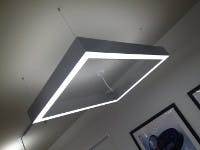The US Department of Energy (DOE) has announced the completion of the Series 19 testing of a group of nine LED linear pendants and a collection of 11 linear pendant products available in both an LED and fluorescent versions.
Fluorescent products typically offer more different configurations, whereas LED are typically only available in one or two lumen packages. The report suggests that, moving forward, LED products would benefit from a wider range of lumen packages.
Luminous efficacy of LED linear pendants is often higher than the efficacy of their fluorescent counterparts. The efficacy for the surveyed LED luminaires reached up to 85 lm/W, with measured efficacy for the products going as high as 79 lm/W. Only two products were less than 50 lm/W. In comparison, the surveyed fluorescent products were between 35 and 75 lm/W.
For products with clear or prismatic lenses, the LED versions did not closely match the luminous intensity distribution of their fluorescent counterparts. However, matching fluorescent is not necessarily a goal; a different distribution and appearance can be the result of delivering light more effectively where it is needed, and avoiding zones where it can cause glare, for example.
The color quality of fluorescent systems is based on the lamp, which is interchangeable and thus easy to change over the lifetime of the luminaire. In contrast, LED arrays are relatively fixed for the lifetime of the luminaire and the only choices are those available from the luminaire manufacturer.






